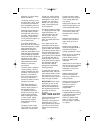16
free-form loaves, let them
rise on an oiled baking sheet
until at least doubled in bulk.
Making consecutive
batches:
You can make several
batches of bread dough
in a row. The motor in
the Limited Edition Metal
™
Ultimate Food Prep Centre
is extremely efficient.
TYPICAL
BREAD DOUGH:
PROBLEMS AND
SOLUTIONS IF
DOUGH BLADE
DOESN’T
INCORPORATE
INGREDIENTS
Always start processor
before adding liquid. Add
liquid in slow, steady
stream, only as fast as dry
ingredients absorb it. If you
hear liquid sloshing, stop
adding it but do not turn off
machine. Instead, wait until
ingredients in work bowl
have mixed, then add
remaining liquid slowly. Pour
liquid onto dough as it pass-
es under feed tube; do not
pour liquid directly onto bot-
tom of work bowl.
Blade rises in work bowl:
Blade may not have
been pushed down as
far as possible before
processing started.
Excessively sticky dough
can cause blade to rise
even though it cleans inside
of work bowl. If dough feels
very sticky, reinsert blade
and immediately add 2
tablespoons (30 ml) flour
through feed tube while
machine is running.
Dough doesn’t clean
inside of work bowl:
• Amount of dough may
exceed maximum capacity
of your food processor.
Remove half and process
in 2 batches.
• Dough may be too dry.
If it feels crumbly, add
water, 1 tablespoon
(15 ml) at a time, while
machine is running, until
dough becomes moist
and cleans inside of work
bowl. Wait 10 seconds
between additions of
water.
• Dough may be too wet.
While machine is running,
add 1 tablespoon (15 ml)
of flour. If necessary, add
more, 1 tablespoon (15
ml) at a time, until dough
cleans inside of work
bowl and forms a ball.
• PowerPrep
®
Metal Dough
Blade is intended only for
recipes calling for at least
3-1/2 cups of flour
(17-1/2 ounces) (875 ml).
If your recipe calls for
less flour, remove metal
dough blade and insert
metal chopping blade.
Always use metal
chopping blade for recipes
calling for less than 3-1/2
cups (875 ml) of flour,
such as pizza dough.
Nub of dough forms
on top of blade and
does not become
uniformly kneaded:
Stop machine, carefully
remove dough, divide into
3 pieces and redistribute
evenly in work bowl.
Continue processing until
dough is uniformly soft
and pliable.
Dough feels tough
after kneading:
Divide dough into 2 or 3
pieces and redistribute
evenly in bowl. Process 10
seconds or until uniformly
soft and pliable.
Soft dough or liquid
leaks onto base of
food processor:
Always start processor
before adding liquid and
add liquid only as fast as
dry ingredients absorb it.
Motor stops:
• Cover may have become
unlocked.
• Power cord may have
become unplugged.
• Excessive strain may have
caused motor to overheat
and stop. Wait for the motor
to cool, 5-10 minutes. A
safety protector in the motor
prevents excessive over-
heating. If the motor stops,
turn machine off. After 5-10
minutes, divide dough into
2 batches and complete
processing. Pinch dough to
make sure that it is not too
stiff to knead comfortably
by hand. If it is, add liquid,
1 teaspoon (5 ml) at a time,
until dough is sufficiently
moist to clean inside ofbowl.
Dough doesn’t rise:
We recommend you always
test activity of yeast before
using, by stirring it and at
least 1/2 teaspoon (2 ml)
sugar into about 1/3 cup
(80 ml) warm liquid
(105 - 120°F) (40 - 48°C).
Within 10 minutes foam
should develop, indicating
yeast is active. Do not use
dry yeast after expiration
date on package.
03CC18070 MP-14C IB 6/17/03 1:55 PM Page 17


















